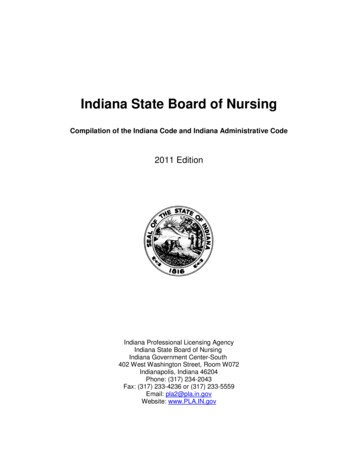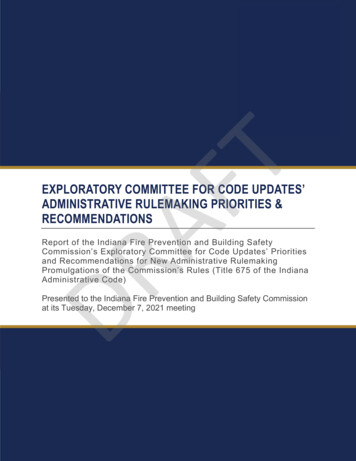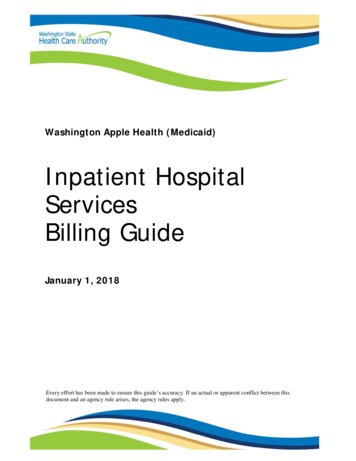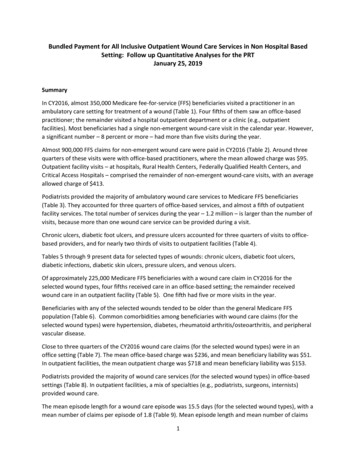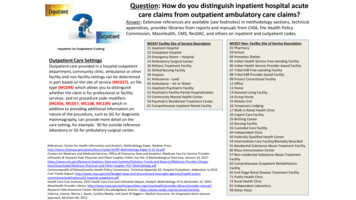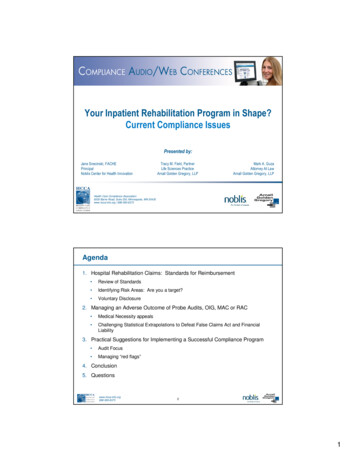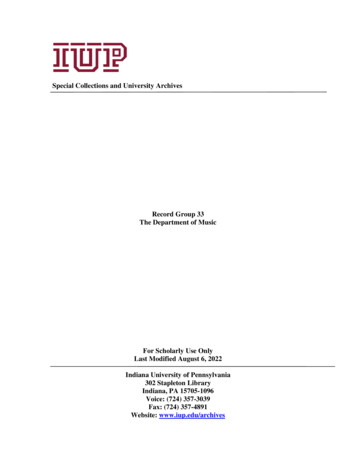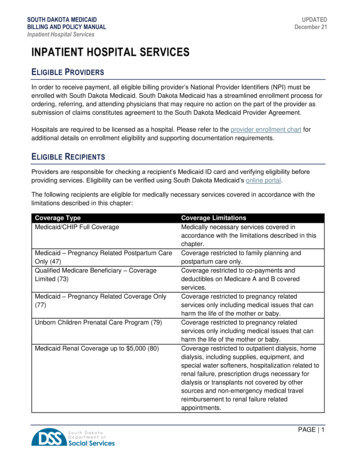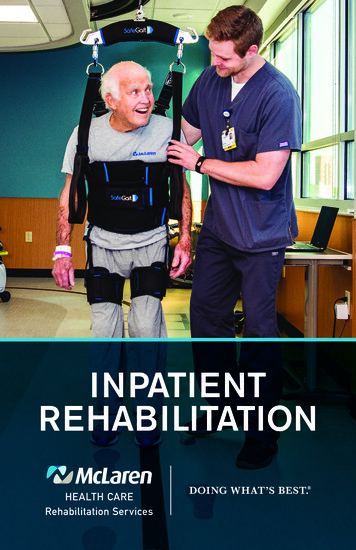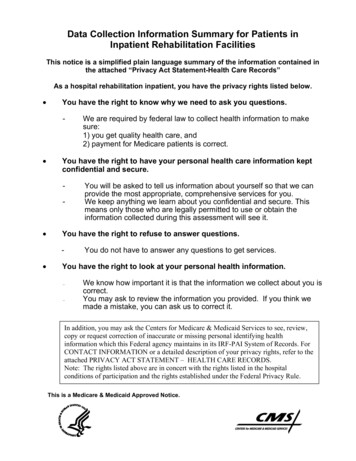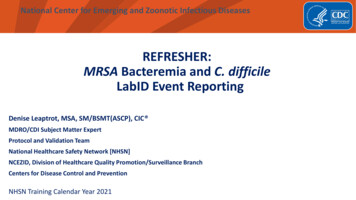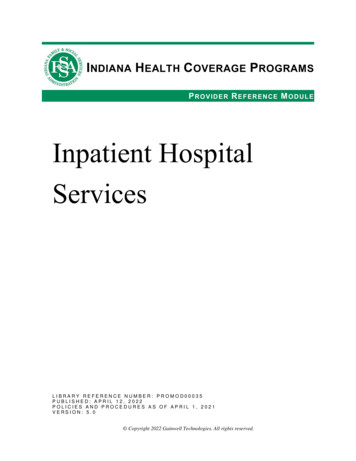
Transcription
INDIANA HEALTH COVERAGE PROGRAMSPROVIDER REFERENCE MODULEInpatient HospitalServicesLIBRARY REFERENCE NUMBER: PROMOD00035PUBLISHED: APRIL 12, 2022POLICIES AND PROCEDURES AS OF APRIL 1, 2021VERSION: 5.0 Copyright 2022 Gainwell Technologies. All rights reserved.
Revision HistoryVersionDateReason for RevisionsCompleted By1.0Policies and procedures as ofOct. 1, 2015Published: Feb. 25, 2016New documentFSSA and HPE1.1Policies and procedures as ofApril 1, 2016Published: Sept. 20, 2016Scheduled updateFSSA and HPE1.2Policies and procedures as ofApril 1, 2016(CoreMMIS updates as ofFeb. 13, 2017)Published: May 16, 2017CoreMMIS updateFSSA and HPE2.0Policies and procedures as ofSept. 1, 2017Published: Nov. 30, 2017Scheduled updateFSSA and DXC3.0Policies and procedures as ofJan. 1, 2019Published: Oct. 1, 2019Scheduled updateFSSA and DXC4.0Policies and procedures as ofMarch 1, 2020Published: June 11, 2020Scheduled updateFSSA and DXC5.0Policies and procedures as ofApril 1, 2021Published: April 12, 2022Scheduled update: Edited text as needed for clarity Replaced DXC references withGainwell Updated the General InpatientBilling and Coding Proceduressection and added Diagnosis Codessubsection Added the Occurrence Codes section Updated the Grouper section Updated the Length of Stay section In the DRG Outlier, Capital Costsand Medical Education CostsPayment section, updated thethreshold amount for outlierpayments Removed the Hoosier HealthwisePackage C Exceptions to DRG andLOC Reimbursement Systems section Updated the Base Rate for Children’sHospitals section In the Hospital-Acquired ConditionsPolicy section, updated the age rangefor pediatric patientsFSSA andGainwellLibrary Reference Number: PROMOD00035Published: April 12, 2022Policies and procedures as of April 1, 2021Version: 5.0iii
Inpatient Hospital ServicesVersionDateReason for RevisionsCompleted By Updated the note in the InpatientBlood Factor Claims section Corrected information in theOutpatient Service Within ThreeDays of an Inpatient Stay sectionivLibrary Reference Number: PROMOD00035Published: April 12, 2022Policies and procedures as of April 1, 2021Version: 5.0
Table of ContentsIntroduction . 1Prior Authorization for Hospital Inpatient Admissions . 1PA Policy for Inpatient Stays for Burn Care . 2PA Policy for Inpatient Stays for Dually Eligible Members . 2Inpatient Admission Criteria . 3Acute Care Hospital Admission and Continued Stay Criteria for Adults . 3Acute Care Hospital Admission and Continued Stay Criteria for Pediatrics . 5Inpatient Rehabilitation Admission and Discharge Criteria. 8Dental Admissions . 9Inpatient Burn Admissions . 10General Inpatient Billing and Coding Procedures . 12Revenue Code Itemization . 12Diagnosis Codes . 12Present-on-Admission Indicators . 13Occurrence Codes . 14Reimbursement Methodology for Inpatient Services . 14Diagnosis-Related Group Reimbursement System . 15Inpatient Level-of-Care Reimbursement System . 17Reimbursement for Capital Costs . 19Reimbursement for Medical Educational Costs . 19Outlier Payments. 20Base Rate for Children’s Hospitals . 20Change in Coverage During Inpatient Stay . 21Inpatient Coverage for Presumptively Eligible Members . 21Inpatient Coverage for Inmates . 21Hospital-Acquired Conditions Policy . 21Reimbursement for Promoting Interoperability Program . 23Long-Term Acute Care Hospital Services . 23Admission Criteria . 23Continued Stay Criteria. 26Discharge Criteria . 26LTAC Billing . 26LTAC Reimbursement . 27Inpatient Blood Factor Claims . 27Medicare Exhaust Claims and Inpatient Services . 28Benefits Exhausted Prior to Inpatient Admission . 28Benefits Exhausted During an Inpatient Stay . 28Observation Billing . 28Transfers . 29Readmissions . 30Inpatient Stays Less Than 24 Hours . 30Expiration Within One Day of Birth . 30Inpatient-Only Codes . 30Outpatient Service Within Three Days of an Inpatient Stay . 31Coding Claims for Newborns. 32Unit and Age Limitations on Inpatient Neonatal and Pediatric Critical Care Services . 32Newborn Screening . 32Newborn Heelstick Screening – Dried Blood Spot Sample . 33Newborn Screening for Critical Congenital Heart Disease – Pulse Oximetry . 33Newborn Hearing Screening – Early Hearing Detection and Intervention . 33Library Reference Number: PROMOD00035Published: April 12, 2022Policies and procedures as of April 1, 2021Version: 5.0v
Inpatient Hospital ServicesNote: The information in this module applies to Indiana Health Coverage Programs (IHCP)services provided under the fee-for-service (FFS) delivery system. For informationabout services provided through the managed care delivery system – includingHealthy Indiana Plan (HIP), Hoosier Care Connect or Hoosier Healthwise memberservices – providers must contact the member’s managed care entity (MCE) or referto the MCE provider manual. MCE contact information is included in theIHCP Quick Reference Guide, available at in.gov/medicaid/providers.For updates to information in this module, see IHCP Banner Pages and Bulletinsat in.gov/medicaid/providers.IntroductionSubject to the limitations described in this module, the Indiana Health Coverage Programs (IHCP) coversinpatient services (such as acute care, mental health and rehabilitation care) when the services are both ofthe following: Provided or prescribed and documented by a physician Medically necessary for the diagnosis or treatment of the member’s conditionNote: This module includes information about IHCP coverage, billing and reimbursementfor inpatient services. For additional information specific to inpatient mental healthand addiction services, see the Behavioral Health Services module.Prior Authorization for Hospital Inpatient AdmissionsIn accordance with Indiana Administrative Code 405 IAC 5-17-2, the IHCP requires prior authorization(PA) for all nonemergency inpatient hospital admissions, with the following exceptions: Routine vaginal and C-section deliveries Inpatient hospital admissions covered by MedicareIn all other cases, nonemergency inpatient hospital admissions – including all elective or plannedadmissions and admissions for which the patient’s condition permitted adequate time to schedule suitableaccommodation – require PA. This requirement applies to medical and surgical inpatient admissions.Newborn stays do not require PA. Observation does not require PA.PA is required for all Medicaid-covered rehabilitation, burn and psychiatric inpatient stays reimbursedunder the level-of-care (LOC) payment methodology, as well as substance abuse stays reimbursed underthe diagnosis-related group (DRG) methodology. (Both reimbursement methodologies are described in405 IAC 1-10.5 and the Reimbursement Methodology for Inpatient Services section of this module.)Emergency inpatient admissions for these diagnoses must be reported to the PA contractor within 48 hoursof admission, not including Saturdays, Sundays or legal holidays, to receive IHCP reimbursement. Daysthat are not prior authorized under the LOC methodology as required by 405 IAC 5-17-2 will not becovered by Medicaid. For all other emergency inpatient admissions, PA is not required.Library Reference Number: PROMOD00035Published: April 12, 2022Policies and procedures as of April 1, 2021Version: 5.01
Inpatient Hospital ServicesAny surgical procedure usually performed on an outpatient basis, when scheduled as an inpatientprocedure, must be prior authorized. See the Surgical Services module for details.All inpatient hospital PAs are requested via telephone. Providers are required to contact the PA contractorat least two business days prior to a nonemergency admission. For contact information, see the IHCP QuickReference Guide, available at in.gov/medicaid/providers.To ensure a 48-hour turnaround, the PA request should be made by a clinical staff person. The facility mustcall prior to the admission and provide criteria for medical necessity.When requesting PA for inpatient admission, providers must provide the following information: Member name and IHCP Member ID (also known as RID) Procedure requested, including revenue code, Current Procedural Terminology (CPT 1) orHealthcare Common Procedure Coding System (HCPCS) code Location service is to be performed (facility) Medical condition being treated, including the International Classification of Diseases (ICD)diagnosis code Medical necessity of the procedure Admitting physician or surgeon Date of admission Estimated length of stay (LOS) National Provider Identifier (NPI) of the requesting provider Documentation of the denial, if requesting retroactive PA for a dually eligible member who has hadcoverage denied by MedicareSee the Prior Authorization module for general information about requesting PA.Note: All out-of-state services require PA, except as indicated in the Out-of-State Providersmodule.PA Policy for Inpatient Stays for Burn CareAll inpatient stays for burn care are excluded from PA requirements when billed with an admit type 1(emergency) or type 5 (trauma). If the member does not have PA, inpatient burn unit claims received withadmit types other than 1 or 5 that group to a burn DRG will continue to deny for explanation of benefits(EOB) 3007 – No prior authorization segment on file for the level of care.PA Policy for Inpatient Stays for Dually Eligible MembersA member who is dually eligible must obtain Medicaid PA for an inpatient stay that is not covered byMedicare. If a stay is covered by Medicare, in full or in part, the member does not require PA. Providers mayrequest retroactive Medicaid PA for dually eligible members if Medicare will not cover the inpatient staybecause the member has exhausted his or her Medicare benefit or if the stay is not a Medicare-covered service.1CPT copyright 2021 American Medical Association. All rights reserved. CPT is a registered trademark of the American MedicalAssociation.2Library Reference Number: PROMOD00035Published: April 12, 2022Policies and procedures as of April 1, 2021Version: 5.0
Inpatient Hospital ServicesInpatient Admission CriteriaThe IHCP follows Milliman guidelines for all nonemergency and urgent care inpatient admissions. If IHCPcriteria already exist, those criteria are used first when determining whether admissions are appropriate. Ifcriteria are not available within Milliman or IHCP policy, the IHCP relies on medical necessitydetermination of current evidence-based practice.The following sections provide criteria for acute care hospital admissions for both adult and pediatricmembers (in accordance with 405 IAC 5-33), as well as admission criteria for hospital inpatientrehabilitation, dental admission and inpatient burn admission.For admission criteria for long-term acute care (LTAC) hospitals, see the Long-Term Acute Care HospitalServices section. For psychiatric admission criteria, including substance abuse admissions, see theBehavioral Health Services module. For additional information about surgical admissions, see the SurgicalServices module.Acute Care Hospital Admission and Continued Stay Criteria forAdultsThe following sections provide criteria for acute care hospital admission for adults based on severity ofillness or intensity of service, as well as criteria for appropriateness of “day of care” for a continued stay.Severity-of-Illness Admission Criteria for AdultsFor acute care hospital admission based on severity of illness, adults must meet at least one of the followingcriteria: Sudden onset of unconsciousness or disorientation (coma or unresponsiveness) Pulse rate less than 50 per minute or greater than 140 per minute Blood pressure (at least one of the following):– Systolic less than 90 or greater than 200 millimeters mercury– Diastolic less than 60 or greater than 120 millimeters mercury Acute loss of sight or hearing Acute loss of ability to move body part Persistent fever equal to or greater than 100 degrees (orally) or greater than 101 degrees (rectally)for more than five days Active bleeding Severe electrolyte/blood gas abnormality, including any of the following:––––––––Na 123 mEq/LNa 156 mEq/LK 2.5 mEq/LK 6.0 mEq/LCO2 combining power (unless chronically abnormal) 20 mEq/LCO2 combining power (unless chronically abnormal) 36 mEq/LBlood pH 7.30Blood pH 7.45 Acute or progressive sensory, motor, circulatory or respiratory embarrassment sufficient toincapacitate the patient (inability to move, feed or breathe); must also meet intensity of servicecriterion simultaneously in order to certify; do not use for back painLibrary Reference Number: PROMOD00035Published: April 12, 2022Policies and procedures as of April 1, 2021Version: 5.03
Inpatient Hospital Services Electrocardiogram (ECG) evidence of acute ischemia; must be suspicion of a new myocardialinfarction (MI) Wound dehiscence of eviscerationIntensity-of-Service Admission Criteria for AdultsFor acute care hospital admission based on intensity of service needed, adults must meet at least one of thefollowing criteria: Intravenous medications and/or fluid replacement (does not include tube feedings) Surgery or procedure scheduled within 24 hours requiring either of the following:– General or regional anesthesia– Use of equipment, facilities or procedure available only in a hospital Vital sign monitoring every two hours or more often (may include telemetry or bedside cardiacmonitor) Chemotherapeutic agents that require continuous observation for life-threatening toxic reaction Treatment in an intensive care unit Intramuscular antibiotics at least every eight hours Intermittent or continuous respirator use at least every eight hoursContinued Stay (Day-of-Care) Criteria for AdultsRecertification for a continued stay in an acute care hospital requires documentation that the adult membermeets the criteria for the appropriateness of day of care, based on medical services, nursing/life supportservices or patient condition, as follows: Medical services (at least one of the following):– Procedure in operating room that day– Scheduled for procedure in operating room the next day, requiring preoperative consultation orevaluation– Cardiac catheterization that day– Angiography that day– Biopsy of internal organ that day– Thoracentesis or paracentesis that day– Invasive central nervous system (CNS) diagnostic procedure, for example, lumbar puncture,cisternal tap, ventricular tap or pneumoencephalography, that day– Any test requiring strict dietary control for the duration of the diet– New or experimental treatment requiring frequent dose adjustments under direct medicalsupervision– Close medical monitoring by a doctor at least three times daily (observations must bedocumented in record)– Postoperative day for any of the following procedures: Procedure in operating room Cardiac catheterization Angiography Biopsy of internal organ Thoracentesis or paracentesis Invasive CNS diagnostic procedure, for example, lumbar puncture, cisternal tap, ventriculartap or pneumoencephalography4Library Reference Number: PROMOD00035Published: April 12, 2022Policies and procedures as of April 1, 2021Version: 5.0
Inpatient Hospital Services Nursing/life support services (any of the following):– Respiratory care–intermittent or continuous respirator use and/or inhalation therapy (with chestphysiotherapy treatment [chest PT], intermittent positive pressure breathing [IPPB]) at leastthree times daily– Parenteral therapy–intermittent or continuous intravenous fluid with any supplementation(electrolytes, protein or medications)– Continuous vital sign monitoring, at least every 30 minutes, for at least four hours– Intramuscular and/or subcutaneous injections at least twice daily– Intake and output measurement– Major surgical wound and drainage care (chest tubes, T-tubes, hemovacs, Penrose drains)– Close medical monitoring by nurse at least three times daily, under doctor’s orders. Patient condition:– Within 24 hours before day of review – Inability to void or move bowels (past 24) notattributable to neurologic disorder– Within 48 hours before day of review – At least one of the following: Transfusion due to blood loss Ventricular fibrillation or ECG evidence of acute ischemia, as stated in progress note or inECG report Fever at least 101 degrees rectally (at least 100 degrees orally), if patient was admitted forreasons other than fever Coma – unresponsiveness for at least one hour Acute confusional state, not due to alcohol withdrawal Acute hematologic disorders, significant neutropenia, anemia, thrombocytopenia,leukocytosis, erythrocytosis or thrombocytosis yielding signs or symptoms Progressive acute neurologic difficulties– Within 14 days before day of review – Occurrence of a documented, new acute myocardialinfarction or cerebrovascular accident (stroke)Acute Care Hospital Admission and Continued Stay Criteria forPediatricsThe following sections provide criteria for acute care hospital admissions for pediatrics based on severity ofillness or intensity of service, as well as criteria for appropriateness of “day of care” for a continued stay.Severity-of-Illness Admission Criteria for PediatricsFor acute care hospital admission based on severity of illness, pediatric members must meet at least one ofthe following criteria: Sudden onset of unconsciousness (coma or unresponsiveness) or disorientation Acute or progressive sensory, motor, circulatory or respiratory embarrassment sufficient toincapacitate the patient (inability to move, feed, breathe or urinate) Acute loss of sight or hearing Acute loss of ability to move body part Persistent fever (greater than 100 degrees orally or greater than 101 degrees rectally) for more than10 days Active bleeding Wound dehiscence or eviscerationLibrary Reference Number: PROMOD00035Published: April 12, 2022Policies and procedures as of April 1, 2021Version: 5.05
Inpatient Hospital Services Severe electrolyte/acid-base abnormality, including any of the following:––––––––Na 123 mEq/LNa 156 mEq/LK 2.5 mEq/LK 6.0 mEq/LCO2 combining power (unless chronically abnormal) 20 mEq/LCO2 combining power (unless chronically abnormal) 36 mEq/LArterial pH 7.30Arterial pH 7.45 Hematocrit greater than 30% Pulse rate outside following ranges (optimally, a sleeping pulse for members under 12 years old):– 2–6 years old: 70–200/minute– 7–11 years old: 60–180/minute– 12 years old: 50–140/minute Blood pressure outside following ranges (systolic/diastolic):– 2–6 years old: 75–125 mm Hg/40–90 mm Hg– 7–11 years old: 80–130 mm Hg/45–90 mm Hg– 12 years old: 90–200 mm Hg/60–120 mm Hg Need for lumbar puncture, where this procedure is not done routinely on an outpatient basis Any conditions not responding to outpatient, including emergency room:––––––SeizuresCardiac arrhythmiaBronchial asthma or croupDehydrationEncopresis (for clean-out)Other physiologic problem (specify) Special pediatric problems (any of the following):– Child abuse– Noncompliance with necessary therapeutic regimen– Need for special observation or close monitoring of behavior, including calorie intake in cases offailure to thriveIntensity-of-Service Admission Criteria for PediatricsFor acute care hospital admission based on the intensity of care needed, pediatric members must meet atleast one of the following criteria: Surgery or procedure scheduled within 24 hours requiring either of the following:– General or regional anesthesia– Use of equipment, facilities or procedure available only in a hospital Treatment in an intensive care unit Vital sign monitoring every two hours or more often (may include telemetry or bedside cardiacmonitor) Intravenous medications and/or fluid replacement (does not include tube feedings) Chemotherapeutic agents that require continuous observation for life-threatening toxic reaction6Library Reference Number: PROMOD00035Published: April 12, 2022Policies and procedures as of April 1, 2021Version: 5.0
Inpatient Hospital Services Intramuscular antibiotics at least every eight hours Intermittent or continuous respirator use at least eight hoursContinued Stay (Day-of-Care) Criteria for PediatricsRecertification of a continued pediatric inpatient stay requires documentation that the member has metcriteria for the appropriateness of day of care, based on medical services, nursing/life support services orpatient condition, as follows: Medical services (at least one of the following):– Procedure in operating room that day– Procedure scheduled in operating room the next day, requiring preoperative consultation orevaluation– If the day being reviewed is the day of admission, any of the following procedures, scheduled forthe day after admission (unless that procedure is usually done at that facility on a same-daybasis): Cardiac catheterization Angiography Biopsy of internal organ Thoracentesis or paracentesis Invasive CNS diagnostic procedure – for example, lumbar puncture, cisternal tap,ventricular tap or pneumoencephalography Gastrointestinal endoscopy– Cardiac catheterization that day– Angiography that day– Biopsy of internal organ that day– Thoracentesis or paracentesis that day– Invasive CNS diagnostic procedure – for example, lumbar puncture, cisternal tap, ventricular tapor pneumoencephalography – that day– Gastrointestinal endoscopy that day– Any test requiring strict dietary control for the duration of the diet– New or experimental treatment requiring frequent dose adjustments under direct medicalsupervision– Close medical monitoring by a doctor at least three times daily (observations must bedocumented in record)– Postoperative day for any of the following procedures: Procedure in operating room Cardiac catheterization Angiography Biopsy of internal organ Thoracentesis or paracentesis Invasive CNS diagnostic procedure, for example, lumbar puncture, cisternal tap,ventricular tap or pneumoencephalography Gastrointestinal endoscopy Nursing/life support services (any of the following):– Respiratory care – intermittent or continuous respirator use and/or inhalation therapy (withchest PT, IPPB), at least three times daily; Bronkosol with oxygen, oxyhoods or oxygen tents– Parenteral therapy – intermittent or continuous intravenous fluid with any supplementation(electrolytes, protein or medications)– Continuous vital sign monitoring, at least every 30 minutes for at least four hoursLibrary Reference Number: PROMOD00035Published: April 12, 2022Policies and procedures as of April 1, 2021Version: 5.07
Inpatient Hospital Services– Intramuscular and/or subcutaneous injections at least twice daily– Intake and/or output measurement– Major surgical wound and drainage care (for example, chest tubes, T-tubes, hemovacs orPenrose drains)– Traction for fractures, dislocations or congenital deformities– Close medical monitoring by nurse at least three times daily, under doctor’s orders Patient condition:– Within 24 hours on or before day of review – Inability to void or move bowels, not attributableto neurologic disorder (usually postoperative)– Within 48 hours on or before day of review – At least one of the following: Transfusion due to blood loss Ventricular fibrillation or ECG evidence of acute ischemia as stated in progress note or inECG report Fever at least 101 degrees rectally (at least 100 degrees orally) if patient was admitted forreason other than fever Coma – unresponsiveness for at least one hour Acute confusional state, including withdrawal from drugs and alcohol Acute hematologic disorders – significant neutropenia, anemia, thrombocytopenia,leukocytosis, erythrocytosis or thrombocytosis – yielding signs of symptoms Progressive acute neurologic difficulties– Within 14 days before day of review – Occurrence of a documented, new acute myocardialinfarction or cerebrovascular accident (stroke)Inpatient Rehabilitation Admission and Discharge CriteriaThe IHCP provides reimbursement for inpatient rehabilitation services when such services are priorauthorized and determined to be medically necessary.Prior authorization is required for all inpatient rehabilitation admissions. Before admission to a physicalrehabilitation unit, an assessment of the patient’s total rehabilitative potential must be completed anddocumented in the medical record. A written plan of care, cooperatively developed by the therapist orpsychologist and the attending physician, is required for all rehabilitation services. Documentation in themedical record must include the member’s condition, IHCP criteria and level of care necessary in therehabilitation unit.The following conditions must be met for reimbursement for physical rehabilitation admission: The patient is medically stable. The patient is responsive to verbal or visual stimuli. The patient has sufficient mental alertness to participate in the program. The patient’s premorbid condition indicates a potential for rehabilitation. The expectation for improvement is reasonable. The criteria listed in 405 IAC 5-32 are met.8Library Reference Number: PROMOD00035Published: April 12, 2022Policies and procedures as of April 1, 2021Version: 5.0
Inpatient Hospital ServicesSeverity-of-Illness CriteriaPer 405 IAC 5-32-1, the following criteria shall demonstrate the inability to function independently withdemonstrated impairment: Cognitive function (attention span, memory or intelligence) Communication (aphasia with major receptive or expressive dysfunction) Continence (bladder or bowel) Mobility (transfer, walk, climb stairs or wheelchair) Pain management (pain behavior limits functional performance) Perceptual motor function (spatial orientation or depth or distance perception) Self-care activities (drink or feed, dress, maintain personal hygiene, brace or prosthesis)Intensity-of-Service CriteriaIntensity-of-service criteria for inpatient rehabilitation are as follows: Multidisciplinary team evaluation at least every two weeks Physical therapy and at least one of the following therapies (totaling a minimum of three hoursdail
Prior Authorization for Hospital Inpatient Admissions In accordance with Indiana Administrative Code 405 IAC 5-17-2, the IHCP requires prior authorization (PA) for all nonemergency inpatient hospital admissions, with the following exceptions: Routine vaginal and C-section deliveries Inpatient hospital admissions covered by Medicare
